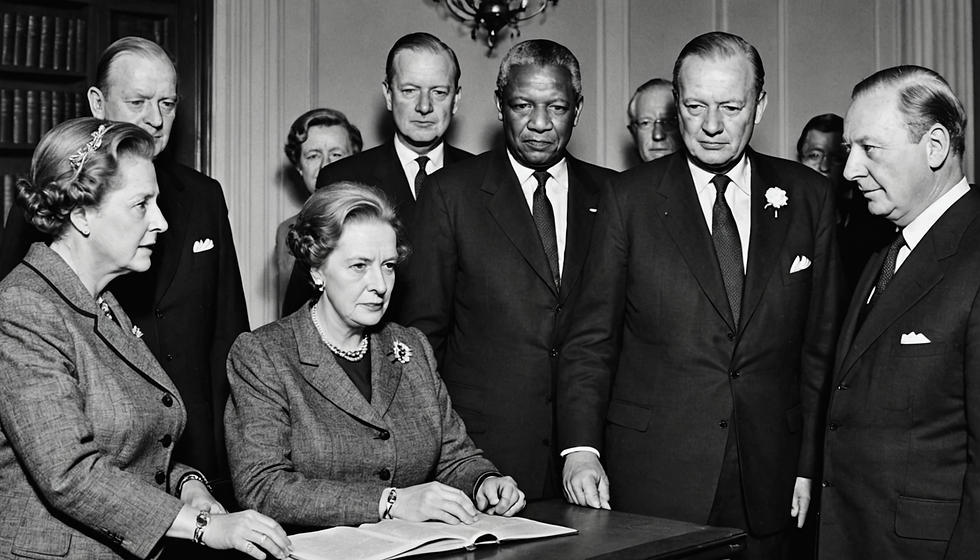Hard vs. soft power: Coercive & referent power in negotiations
- R.M. Boylan

- Feb 23
- 7 min read
Updated: Feb 26
R.M. Boylan BSc. M.A.

Hard vs. Soft Power
Hard power and soft power are two distinct approaches to influence and leadership. Hard power refers to the use of coercive tactics, such as military force or economic sanctions & violence, to achieve political or leadership objectives. In contrast, soft power relies on persuasion, attraction, and the ability to shape the preferences of others through cultural influence, diplomacy, and values.
Higher faculties of the mind in leadership
In order to use the higher faculties of the mind, one must have access to the neurons in the higher mind. That implies the higher executive functions of the mind the prefrontal cortex must be developed to its full capacity for use. This requires optimum development from birth until the age of 25 for females and 27 for males. After 27 years of age, it is too late to develop this critical part of the brain in a human being or leader, the hardware is complete so is the value system.
For decision-making and evaluating the consequences of decision-making for leadership the prefrontal cortex is the most important part of the brain for a leader. Neurons are required in the prefrontal cortex and it cannot be a half job. These neurons are paramount for effective leadership and decision-making. The neurons are developed before the age of 25 in females and 27 years of age in males. The reptilian core of the brain is not a brain system for decision-making in leadership as it is akin to an animal and reacts like one with impulsivity. Therefore the higher executive functions of the brain must be in top shape and highly developed in all leaders for effective and responsible leadership.
Ego development is a construct for evaluating leaders and humans to determine what level of development they are at. This can indicate their ability to reason at higher levels. It is the only instrument and test thatcan evaluate whether a leader is a danger to himself, to others and the world.
Hard Power Sources
Military Force: The use of armed forces to compel or deter actions by other states or entities.
Economic Sanctions: Imposing restrictions on trade or financial transactions to influence behavior through economic violence.
Coercive Diplomacy: Threatening to use force or other forms of pressure to compel compliance.
Soft Power Sources
Cultural Influence: Promoting cultural values and practices that resonate with others.
Diplomacy: Engaging in dialogue and negotiation to resolve conflicts and build relationships.
Ideological Appeal: Attracting others through shared beliefs and values.
Referent Power and Coercive Power
Referent power is derived from the personal qualities and relationships of a leader, leading others to follow them out of admiration or respect. Coercive power, on the other hand, is based on the ability to impose penalties or sanctions. While referent power fosters loyalty and voluntary compliance, coercive power often leads to fear and compliance out of necessity.
Use of Force and Violence in Leadership
The use of force and violence in leadership is often associated with hard power and can manifest in authoritarian regimes. Leaders who rely on coercive measures may do so to maintain control, suppress dissent, or achieve specific goals. However, such approaches can lead to instability, resistance, and long-term repercussions for governance.
Relation to Authoritarianism and Psychopathy
Authoritarianism often employs hard power to maintain control over populations, utilizing coercive tactics and limiting freedoms. Psychopathy, characterized by a lack of empathy and remorse, can be a trait found in some authoritarian leaders, leading to a greater propensity for violence, torture and manipulation. It has been demonstrated that persons with authoritarianism are on lower levels of ego development.
Neurological Aspects: Brain Development and Function
“A marked lack of empathy is a hallmark characteristic of individuals with psychopathy,” explains Jean Decety, the Irving B. Harris Professor in psychology and psychiatry at the University of Chicago in Illinois, and a world-renowned expert on the neuroscience of empathy,
Leadership has been polluted historically by an antiquated model celebrating a radical violent form of leadership which lacks empathy, morality in business and politics. This masculine model of leadership holds contempt for women, promotes hate, violence, torture, rape, gratuitous murder, selfishness, callousness, dishonesty, pedophilia, human trafficking, wealth building, larceny and violence. It is important for us to understand the clinical aspects of this model and the dangers we have created not updating it with the actual academic research.
The neurological underpinnings of behavior can provide insights into leadership styles:
"The study showed that psychopaths have reduced connections between the ventromedial prefrontal cortex (vmPFC), the part of the brain responsible for sentiments such as empathy and guilt, and the amygdala, which mediates fear and anxiety.
Two types of brain images were collected. Diffusion tensor images (DTI) showed reduced structural integrity in the white matter fibers connecting the two areas, while a second type of image that maps brain activity, a functional magnetic resonance image (fMRI), showed less coordinated activity between the vmPFC and the amygdala."
Reptilian Brain vs. Higher Executive Functions
Reptilian Core: Responsible for survival instincts, aggression, and basic functions. It governs responses to threats and can drive individuals toward coercive behaviors.
Higher Executive Functions: Involves decision-making, empathy, and social interactions. These functions are crucial for effective leadership and the ability to employ soft power.
Neuroplasticity and Compassion
Neuroplasticity refers to the brain's ability to reorganize itself by forming new neural connections. This adaptability allows individuals to develop empathy and compassion, which can foster more effective leadership styles that prioritize soft power over hard power.
Animal vs. Human Evolution in Development
Evolutionary development has shaped human behavior and cognitive abilities. While many animal species rely on instinctual and aggressive behaviors for survival, humans have evolved to possess advanced cognitive functions that allow for complex social interactions, empathy, and moral reasoning. This evolution emphasizes the potential for change through compassion and understanding. In order to use the higher faculties of the mind in the higher executive functions of the mind, neurons are required in the prefrontal cortex. Without the prefrontal cortex humans behave like Philistines, barbarians, animals and savages. I can evaluate a human being's level of development and brain development by their belief systems and level of savagery which implies neurological development.
Dr. Kevin Dutton's book, "The Wisdom of Psychopaths: What Saints, Spies, and Serial Killers Can Teach Us About Success," explores the traits often associated with psychopathy, such as fearlessness, focus, and ruthlessness, and how these traits can be beneficial in certain contexts, particularly in high-stakes environments. Dutton argues that while psychopathy is often viewed negatively, certain psychopathic traits can contribute to success in various fields, including business, politics, and the military where greed, murder may be celebrated by males.
Psychopathy and Brain Development
Research indicates that individuals with psychopathic traits often exhibit differences in brain structure and function. Key areas of the brain that show atypical development in psychopaths include:
1. Amygdala:
- The amygdala is crucial for processing emotions, particularly fear and empathy. Psychopaths often show reduced activity in this region, which may contribute to their lack of empathy and emotional responses. In leadership, this can be a problem if the prefrontal cortex is underdeveloped. Specifically, with a leader who has access to nuclear weapons and is incapable of evaluating the consequences of his decisions due to impaired functioning in the higher executive functions of the brain.
2. Prefrontal Cortex:
This area is associated with decision-making, impulse control, and social behavior. Dysfunction in the prefrontal cortex can lead to poor judgment and an inability to consider the consequences of one’s actions, traits commonly observed in psychopaths. In leadership, this can be a problem if the prefrontal cortex is underdeveloped. When neurological development is lacking, neurons are lacking for critical reasoning around problem solving and consequence. Specifically, with a leader who has access to nuclear weapons and is incapable of evaluating the consequences of his decisions due to impaired functioning in the higher executive functions of the brain.
3. Insula:
The insula is involved in the awareness of bodily states and emotions. Reduced activation in this area may correlate with the inability to empathize with others' feelings. Because leaders with psychopathy have no empathy or fear, they enjoy harming and torturing others. For them torturing, harming, raping and killing others is entertainment. It becomes a game for them which turns into an addiction which is uncontrollable. For this reason war, greed, status building, wealth building and harm are not mutually exclusive but rather are part of an addictive circle that cannot be broken. As a group of men with this dysfunctional addiction, their addiction becomes mass murder.
Lack of Empathy in Psychopaths
The lack of empathy in psychopaths is often attributed to the underdevelopment or dysfunction of the amygdala and insula. This neurological basis explains why psychopaths can engage in manipulative or harmful behaviors without experiencing guilt or remorse. Their emotional detachment allows them to pursue goals without the constraints of empathy, which can be advantageous in competitive environments.
Authoritarian Leaders and Brain Development
Authoritarian leaders who engage in harmful behaviors, such as torture, wars, threats, intimidation or violence, may also exhibit similar brain dysfunctions, although the motivations and contexts can differ. The following areas are often implicated in the behaviors of authoritarian figures:
1. Amygdala:
Similar to psychopaths, authoritarian individuals may have an overactive amygdala, leading to heightened fear responses and aggression. This can contribute to their willingness to use violence to maintain control.
2. Prefrontal Cortex:
A poorly developed prefrontal cortex can result in impulsive decision-making and a lack of moral reasoning. Authoritarian leaders may prioritize power over ethical considerations, leading to harmful actions against others.
3. Anterior Cingulate Cortex (ACC):
- The ACC is involved in impulse control and emotional regulation. Dysfunction in this area may reduce the ability to empathize with others, facilitating authoritarian behavior that disregards the well-being of individuals or groups.
Dr. Kevin Dutton's exploration of psychopathy highlights the complex interplay between brain structure, emotional processing, and behavior. Both psychopaths and authoritarian leaders exhibit specific neurological traits that contribute to their capacity for manipulation, aggression, and a lack of empathy. Understanding these brain mechanisms can provide insight into the behaviors of individuals who operate outside the norms of empathy and morality, whether in personal or leadership contexts.
Conclusion
In summary, the dynamics of hard power and soft power are deeply intertwined with concepts of referent and coercive power. The neurological differences between the reptilian core and higher executive functions highlight the potential for leadership styles to evolve. By fostering compassion and understanding, leaders can cultivate environments that promote cooperation and positive change, moving away from authoritarian practices and coercive measures.
References
- Dutton, K. (2012). *The Wisdom of Psychopaths: What Saints, Spies, and Serial Killers Can Teach Us About Success.* Crown Publishing Group.
- Blair, R. J. R. (2007). *The neurobiology of psychopathy.* *Psychological Medicine*, 37(5), 781-791.
- Raine, A. (2002). *Biosocial Studies of Antisocial and Violent Behavior.* *In Handbook of Antisocial Behavior*, 20-34.





Comments